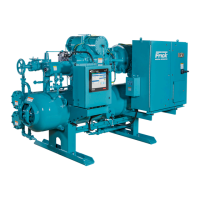070.610-IOM (JUL 21)
Page 24
RWF II Rotary Screw Compressor Units
Operation
compressor is moved by the compressor rotors out the
compressor outlet and back to the oil separator.
For normal high-stage operation, an oil pump is not
required.
Demand pump oil system
This system is designed to provide adequate compres-
sor lubrication when there is low differential oil pressure
across the compressor suction and discharge for some
high stage applications and booster applications as re-
quired.
On start-up, Quantum
™
HD will calculate the pressure dif-
ferential between the compressor discharge and the main
oil injection port. If this differential is less than 35 psi, then
the demand pump will turn on and will continue to run
until 45 psi differential is obtained. Then, the pump will
shut down and start only when the differential pressure
falls below 35 psi.
WARNING
The oil pump relief valve is not intended to be ad-
justed. Do not attempt to remove or unscrew the
relief valve bonnet. Removal of the bonnet will result
in major oil or refrigerant loss.
NOTICE
For alarm descriptions and shutdown or cutout pa-
rameters, see publication 090.040-O.
Compressor oil separation system
The RWF II is an oil ooded screw compressor. Most of
the oil discharged by the compressor separates from the
gas ow in the oil charge reservoir. Some oil, however,
is discharged as a mist which does not separate readily
from the gas ow and is carried past the oil charge reser-
voir. One or more coalescer lter elements then coalesce
the oil mist into droplets which fall to the bottom of the
coalescer section of the oil separator. See Figure 26. The
return of this oil to the compressor is controlled by a
throttling valve on both high stage and booster applica-
tions.
NOTICE
Open throttling valve only enough to keep coalescer
end of separator free of oil.
The sight glass located near the bottom of the coales cer
section of the oil separator should remain empty during
normal operation. If an oil level develops and remains in
the sight glass, a problem in the oil return separation sys-
tem or compressor operation has developed. See Mainte-
nance for information on how to correct the prob lem.
NOTICE
The normal operating level is midway between the two
sight glasses located midway along the oil separator
shell.
Figure 26: Oil separation system
Cold-start system
The RWF II package is equipped with a special "cold-start"
discharge check valve (see Figure 27) on the gas outlet
connection of the oil separator. This valve causes the oil
separator to develop oil pressure rapidly on initial start in
order to lubricate the compressor without requiring an oil
pump, even in cold ambient temperatures with all pres-
sures equalized.
For high-stage packages, the cold-start valve is equipped
with a large spring that creates 30 psi of pressure in the
oil separator (above suction pressure), for lubrication of
the compressor.
Once the compressor is running it will begin to force gas
to the condenser at connection P2. As the condenser
heats up it will begin to rise in pressure as the compres-
sor suction pulls down in pressure. As soon as differential
pressure is developed between the condenser and suction,
these pressures act across a piston inside the cold-start
valve to partially overcome the spring force. When the dif-
ferential pressure reaches and exceeds 30 psi, the piston
fully overcomes the spring force and powers the valve fully
open for very low operating pressure drop.
For booster applications, the valve is equipped with a
lighter spring which produces 7 psi oil pressure above suc-
tion pressure before it fully powers open. An oil pump is
required to ensure compressor lubrication.
The RWF II package is also equipped with a suction check
valve bypass. The oil separator will slowly bleed down
to approximate system suction pressure when the unit is
stopped. This allows the compressor drive motor to have
an easier start, and the discharge check valve will seat
more tightly. See Suction check valve bypass for opera-
tion.
NOTICE
For alarm descriptions and shutdown or cutout pa-
rameters, refer to publication 090.040-O.

